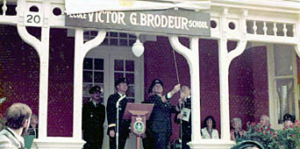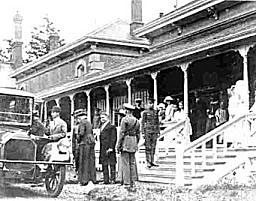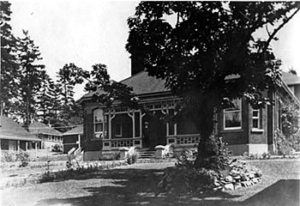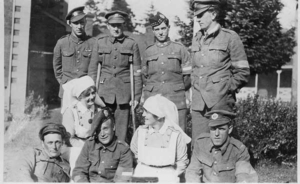Distinguished Buildings
A History of
Building 20, Naden
It began life as a hospital ward for sick officers in 1891, and during the course of its ‘career’ with the navy, has served, variously, as a residence for senior staff, as part of a training facility, and as a Francophone elementary school.
Today, Building 20 at Naden serves yet another purpose, as the archives and research centre for a thriving naval and military museum, and as part of a complex of historic buildings of nationally recognized significance.
In 1888, the South Ward (currently building #35) was opened, to be followed by the North Ward (Building #39) in 1889, the Administration Building (Building #37) in 1889, the Sick Officer’s Ward (Building #20) in 1891(Drawing D1891), and the Stores Building (Building #29) between 1890 and 1894.
A famous Victoria architect, John Teague, is thought to have designed these buildings. Teague worked for the Royal Navy as an architect, and in 1885, designed a house for the Naval Stores Officer, now the Admiral’s House at Her Majesty’s Canadian (HMC) Dockyard, Esquimalt. In his diaries, builder John Dean also refers to a meeting with Teague a week before Dean signed a contract to construct the buildings within the hospital complex.
The buildings in the hospital complex are the second set of structures on the site, the first having been built to house the Royal Engineers, who surveyed the Canada/US border in the early 1860s. These buildings also comprised the original hospital on the site, which was closed in 1869, reopened in 1872, and later demolished to make way for the current buildings.
This complex operated as a hospital until 1905, when the Royal Navy closed it in preparation for the abandonment of the Pacific station. It came under the supervision of a caretaker until the First World War, when it was opened in 1915 under the auspices of the Royal Canadian Navy (established in 1910).

The official opening of the Victor G. Brodeur School for Francophone elementary students, CFB Esquimalt.
The Esquimalt Military Convalescent Hospital became what was termed a “Disabled Soldiers Re-establishment Hospital”, and was operated by the Military Hospitals Commission. Its purpose was to provide shelter and rehabilitation for shell-shocked soldiers and wounded service personnel, as well as those suffering from tuberculosis.
Following a short period of closure after the end of the First World War, the complex was re-opened by the RCN in 1922 and formed the nucleus of the West Coast training establishment, HMCS NADEN. The hospital wards were converted into training facilities and barracks for officer’s and men, with Building 20 becoming office space.
In 1925, Building 20 was further converted to use as the Senior Officer’s Residence, and continued in that use until the advent of World War Two.
Distinguished occupants of Building 20 have included Percy Walker Nelles (later Admiral Nelles), Leonard Warren Murray (later Rear Admiral Murray), and Victor G. Brodeur (later Rear Admiral Brodeur).

HRH Prince Arthur, Duke of Connaught visiting the hospital in 1918 (Prince Arthur is third from the left). He was in Esquimalt after a visit to Japan where he had met with the Emperor.
In 1942, Building 20 was converted to office use and, following the rapid growth of the RCN, was set to further uses as the needs of the training establishment at Naden changed. The requirements for medical facilities changed after the First World War, and the buildings in the hospital complex were used for non-medical purposes, to house officers for example.
Building 20, where the museum administrative offices, library, and archives are located, has served as a nurses’ residence, the residence for Naden’s commanding officer, administrative offices, and a francophone elementary school, Victor G. Brodeur school.
Today, all but two of the original hospital buildings still stand. The two buildings missing from the complex — one originally the naval hospital’s staff quarters, kitchen, and dining room, and the other the medical officers’ quarters — were torn down in the 1950s.
In 1985, Building 20 was incorporated into the CFB Esquimalt Naval Museum, and continues in that use to this date, serving as general office and archival space.
The photograph (right) shows a 1918 visit to the hospital by Britain’s Prince Arthur. The building immediately up the stairs from the Prince once housed the hospital’s administrative offices, operating theatre, and dispensary. Today this building contains the museum’s naval exhibits and gift shop.
By Clare Sharpe
Museum staff member
With grateful acknowledgement to Ken Johnson and Don Koehler, on whose research this article is based.


